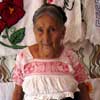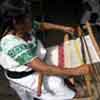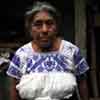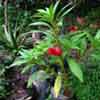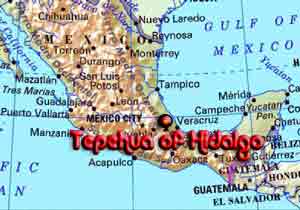 |
 |
 |
 |
|
||||||||||||||||||||||||||||||||||||||||||||||
|
The communities that are included in this gallery are all very close to Huehuetla, in fact they are neighborhoods in reality. The town has grown into them. The carnival ( Mardi Gras) is a week long event which is distinct to the surrounding Otomi celebration and culminates with a fire dance. The town did a census of women still wearing traditional costume and in 2005 there were 80 women left. The old belt weaver has hurt her back and no longer weaver and Maria Cresencia the last quechquemitl weaver still weaves. there will be a seperate video and phot gallery of the Quechquemitl process in the near future. Bob Freund The Tepehua ("teh-PAY-wa") people are often confused with the Tepehuan ethnic group of northern Mexico. However, the Tepehua people live in central Mexico and are closely related linguistically to their neighbors, the Totonacs. Totonac and Tepehua together form the Totonac-Tepehua language family. The Tepehua occupy a long, narrow territory on the eastern slopes of the Sierra Madre Oriental from the Mecapalapa area of Puebla to several municipios in far northwesternVeracruz. The three major Tepehua population centers are Tlachichilco, Veracruz and the towns of Pisa Flores and Huehuetla in Hidalgo. The three major dialects of the Tepehua language correspond with these communities. In their own language, the Tepehua call themselves "Hamaispini" ("Dueños del Cerro" in Spanish). The 1990 Mexico census identified approximately 8,700 people age five and older who spoke Tepehua. In terms of culture and religion, the Tepehua share many traits with their eastern neighbors, the Totonacs, and with their neighbors to the west, the Otomis and the Nahuas. This includes the use of paper spirit figures in shamanism and the "voladores" pole ceremony. The Tepehua are, in general, peasant agriculturalists. They occupy a tropical region rich in rivers, streams, and abundant rainfall. Families grow the traditional subsistence foods of maize, squash, beans, and chiles, along with coffee and sugar cane. Some farmers cultivate other crops, too, such as onions, sweet potatoes, sesame, and lentils. Most families keep domestic animals and fowl, and supplement their food supplies by fishing and hunting. Tepehua men, like indigenous men throughout Mexico, often leave home for wage labor elsewhere, and some families earn income through the production of crafts such as baskets, ceramics, and textiles. The traditional costume of Tepehua men is similar to that found among the Totonacs and Nahuas of the Sierra Madre Oriental - a white, long-sleeved shirt, ankle-length white pants, sandals, a shoulder bag, machete, and a straw hat. The traditional woman's costume consists of a short-sleeved white blouse decorated with a combination of pepenado smocking and machine embroidery. This is worn tucked into a white tube skirt, which is traditionally 4 meters wide and is pleated in front of the woman's body. The hem of the skirt is decorated with a band of machine embroidered designs. Both skirt and blouse are made from commercial cloth. Women wear wide, black and white backstrap woven belts. A gauzy, white backstrap woven quechquemitl is also worn on the upper body (points in front and back) or wrapped "pirate style" around the woman's head. The Cordrys visited Huehuetla, Hidalgo in 1965 and described and photographed the unique process used by Tepehua women to make their quechquemitls (called "quexquen") locally. After the two pieces of cloth that make up the quexquen are woven, they are washed thoroughly; then folded so that the red or pink dyed bands of brocade come in contact with plain, white cloth. The folded fabric is wrapped in a large leaf, placed on a clay comal (used to cook tortillas), and steamed for about 10 minutes. Some women place a half-gourd on top of the leaf-enclosed cloth while it steams; others do not. It's been suggested that this process has to do with female fertility. In any case, the washing, folding, and streaming results in the stamping of the white parts of the quexquen with fugitive designs in a red or rose color. Stamping designs on plain fabric by folding and pressing dyed areas to undyed areas is a technique still found today in some Mixtec communities in Oaxaca, notably Santiago Ixtayutla. The points of the quexquen are embroidered with "tree of life" designs, and the two pieces of fabric are joined together with a wide satin ribbon. |
|||||||||||||||||||||||||||||||||||||||||||||
|
||||||||||||||||||||||||||||||||||||||||||||||
